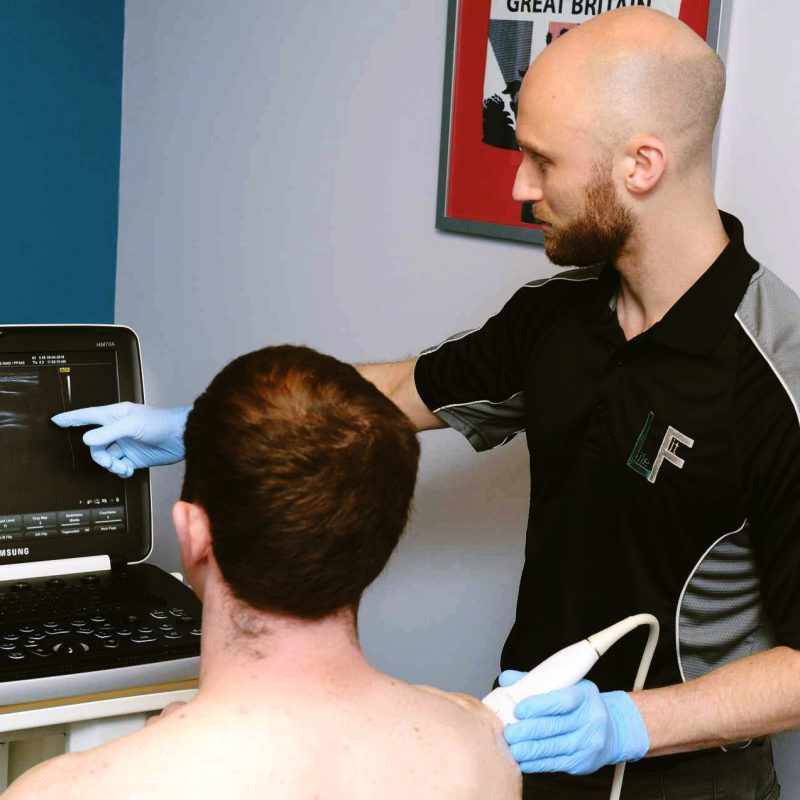Stewart Kerr, Advanced Practice Physiotherapist, takes use further into the subject of shoulder problems.
So it’s been a little longer than anticipated in writing this blog however here we are as promised in my previous blog (Link)….a few thoughts on different types of shoulder problems.Let’s get one things sorted first; when is a shoulder not a shoulder? When it’s a neck! When people present in the clinic with shoulder pain we firstly need to determine if it is indeed the structures of the shoulder that are causing the pain or whether the pain is referred from somewhere else. One of the most common regions to refer pain to the shoulder is the neck. Just like all great double acts (Tom & Jerry, Laurel & Hardy, French & Saunders etc.), one doesn’t function well without the other. They have both structural and anatomical relationships but also a sensory relationship. What does this mean? Well, the origin of the nerves that supply the shoulder (nerve root) is in the neck. As such, irritation of these nerve roots can give the perception of pain in the shoulder when the origin of the problem is actually in the neck. Furthermore, there is some decent research demonstrating that some shoulder muscles are weak in the presence of neck problems and neck strength can be reduced in the presence of shoulder problems. So, don’t be confused if your physio takes a good look at your neck even if you feel there’s no issue with it. There are some other structures that can refer symptoms to the shoulder but we won’t worry about that just now – leave that to us!

OK, now we’ve got that out the way….when a shoulder is a shoulder, what’s going on? The first thing we need to ask is whether there has been any significant trauma to the shoulder. Now this is a debatable issue within shoulder specialists; how do you determine trauma? A jerk when lifting something awkwardly? A jolt when a child pulls on your arm? Or a high velocity crunching tackle in rugby or a fall from a set of ladders? Really what we are taking about is more like the latter than the former and I am always really interested in the specific details of anything that an individual considers trauma such as body position and forces through the arm during such incidents. Once that’s established there are still an almost endless list of specific shoulder diagnoses but it is sometimes helpful for clinicians and patients alike to group these into three main categories:
- Weak and painful shoulder
- Stiff and painful shoulder
- Unstable shoulder
Weak & Painful
Let’s take the weak and painful shoulder. In the absence of trauma the vast majority of the time this is an issue with the rotator cuff tendons (although biceps tendons can sometimes be the issue too). The rotator cuff are a group of 4 muscles and their tendons that almost encapsulate the ball and socket joint (glenohumeral joint). They are the main dynamic stabilisers of the shoulder and play a very important role in upper limb function. They can however become irritated and painful as a result of ‘overuse’ which can often be as subtle as taking a break from an activity and returning to it or doing a solid bout of DIY such as painting a ceiling. There are so many different terms out there (such as subacromial impingement, subacromial bursitis, rotator cuff tendinopathy, rotator cuff related shoulder pain and subacromial pain syndrome), however in all these cases the rotator cuff muscles and tendons will most likely be painful and weak.
The mainstay of treatment in this situation is always exercise-based. This is where the greatest body of evidence lies and people can get great success from consistently following an appropriate program over a suitable period of time. Be warned however, it can take anywhere from 3-6 months for this condition to settle, even with good treatment. Always bear in mind that recovery is a continuum and while everyone would love their issue to resolve yesterday, you are likely to see gradual progression of symptoms and function. It is important to follow rehab through to completion, especially if strength and control deficits are identified: pain may subside but if the other factors are not addressed then the issue has a greater likelihood of returning.
Treatments such as manual therapy (joint mobilisation and massage) and application of tape are commonly used alongside rehabilitation exercises. They can provide some value but should not really be used as a stand-alone treatment as they’re not going to make you stronger!
There are other treatment options available but are not normally considered until a good period of rehabilitation has been undertaken or if the patient is unable to cope with their symptoms, especially if it is affecting sleep. Injections are an option for some and can provide pain relief, but remember an injection will not sort out your strength so ideally rehab is done as well.
Surgery for this issue has been performed for many decades however over the last few years has become an increasingly contentious issue. A recent large-scale study conducted across multiple surgical centres across the UK indicated that so called “decompression” surgery was no better than placebo in the treatment of this type of condition. Now this doesn’t mean that it shouldn’t be offered and there are clearly some who respond well to this, however what we often find is that patients have an enforced period of rest following surgery and they are much better at adhering to rehabilitation after the surgery than they are at doing their exercises prior to surgery……..what conclusions could we draw from that?
I once asked a patient, who was due for this type of surgery the following week, “have you been good at doing your exercises up to now?”. “No” she replied. I then asked “will you do your exercises after your surgery?” “Yes, I wouldn’t want to mess that up!” was the reply. Following a little discussion she then cancelled her operation, really knuckled down with her rehab and made a full recovery in 4 weeks. Had she gone for surgery she would still have been unable to drive 4 weeks later. The lesson here is that exercise can work but it needs dedication – this isn’t easy and I don’t take it for granted, in fact I am actually working on a VLOG on this very subject for our You Tube Channel. There are various tips and tricks that a physiotherapist can give you to make sticking with rehab easier.

Stiff & Painful
Now, this can become a little confusing as a rotator cuff issue can feel very stiff to the individual affected when they try to move it but what we really mean with a stiff shoulder is that the clinician cannot move the shoulder any further than the patient is able to. So for example a person may only be able to actively move their shoulder through 30 degrees of external rotation (elbow bent and by the side rotating the hand outwards), however if the clinician is able to move the arm to 60 degrees their shoulder is not considered clinically stiff. If on the other hand the clinician also can only move the arm through 30 degrees of external rotation, this would possibly indicate a clinically stiff shoulder.

Perhaps the most common type of stiff shoulder presentation is a Frozen Shoulder. For more on what a Frozen Shoulder is see my You Tube video here. When a frozen shoulder is well established it can be a reasonably simple diagnosis to make. Not to confuse matters, however when it is in the early stages (and I see quite a few of these as I offer quick access to my clinic), it can be a little more difficult to determine and can be confused with a weak and painful rotator cuff type problem. The history of the problem and a thorough clinical examination are essential here, however the addition of imaging (x-rays and scans), plus guided injections can have added value. As a physiotherapist and sonographer, I will often utilise a diagnostic ultrasound scan which can show some key features of a Frozen Shoulder, and I may also utilise an ultrasound guided injection into a specific region. This guided injection gives me confidence that I have injected very accurately into a specific area and if that patients symptoms resolve then I can have good assurance that the structure injected has been causing some or all of their symptoms.
Once the diagnosis of Frozen Shoulder is established then specific treatment can commence. Sometime it can be a good option to commence a period of physiotherapy-led exercises which will primarily be designed to stretch out the affected soft tissue capsule of the shoulder. Massage and joint mobilisation can also be used alongside a home program which for some can provide adequate relief from symptoms.
If limited progress is being made or if the conditioning is worsening, personally I wouldn’t wait too long in offering a steroid injection. In the ideal world we want to stop the Frozen Shoulder from developing more than it has to as once it is really stuck it can be exceptionally debilitating.
Now, there is another specialist injection procedure called a hydrodistention. This is essentially the addition of a high volume of sterile water solution into the joint in an effort to stretch the capsule from the inside out. Steroid is usually injected at the same time and this can provide pretty significant improvements for a good portion of patients however the exact details of which patients will benefit and to what extent remain unclear. That said, it remains a reasonable option for some who have failed to respond to a steroid injection alone.
The final treatment options lie in the surgeons hands. Traditionally a ‘manipulation under anaesthetic’ was performed where the shoulder was essentially stretched out while the patient is under general anaesthetic meaning that their arm is totally relaxed and they are not affected with pain during the procedure. This is still done and can form the initial basis of a surgical procedure called a ‘capsule release’. This is typically performed using keyhole (arthroscopic) surgery and the affected regions of the capsule are accurately released. This procedure tends to have the most effective results once the Frozen Shoulder advances. One thing is consistent however with all of the treatment options; a good stretching program and rehabilitation is advisable.

Unstable Shoulder
The so called ‘wobbly’ shoulder……let’s keep this simple! People can have a traumatic (pulled out) and atraumatic (falls out) shoulder instability.
Trauma such as falling from a bike and tackles or falls on the rugby field can cause the ball and socket (glenohumeral) joint to dislocate. Sometimes the shoulder goes back with relative ease either by itself or by the individual affected. Other times it needs assistance of a medical professions and can sometimes it requires medication for pain and relaxation to allow this to happen. Once the shoulder goes back into joint the management options can be varied. Most will be put in a sling for a period of time. The length of time people should stay in the sling is debatable. Research shows that shorter periods of time in the sling do not have any significant impact on the long term outcome and can allow people to prevent secondary issues such as shoulder stiffness and weakness to develop as a result of being immobilised. I think a sensible approach is to wear a sling at least for a few days and then depending on how the shoulder feels start coming out of the sling in controlled situations where it is unlikely to be pushed or pulled. After the initial recovery patients would certainly be advised to seek out some physiotherapy to restore function. I may be biased but I think this is very important regardless of who you are as many aspects of function are affected with a traumatic dislocation. If not fully rehabilitated, patients can be left with a loss of function and a sense of apprehension when moving the arm in particular positions. Surgery can also be an option, and potentially a good option for younger patients intending on returning to higher risk activities (such as rugby). Males under 25 years old with a first time (anterior/forwards) dislocation are likely to benefit from surgical stabilisation.
Some folk can have wobbly shoulders without having any significant trauma. This can be due to quite a number of factors, such as underlying hypermobility syndrome and issues related to muscle functioning, however that is a bit too complicated for this piece. The main-stay of treatment with this group is rehabilitation and most often from a shoulder specialist or someone with experience of working with this group. As with most things, my approach would generally to be to look at the big picture and the person behind the shoulder and build a program suitable to them and for their needs.

The AC Joint
Now most, if not all, of the above I have written with the ball and socket joint in mind. Some, if not most, of the info will relate however to the AC (acromioclavicular) joint, which is the joint between the collar bone and shoulder blade. It will require certain specific consideration however and examination is important to determine if it is the issue and if so what the specific nature of the problem is (i.e. osteoarthritis, dislocation or a sprain). All of the treatment options discussed above can apply to the AC joint and the specifics of each presentation will determine the best course of action. Pain from the AC joint is usually well located over the joint itself which is situated at the tip of the shoulder. So if there is focal pain and tenderness to touch at the top of the shoulder over the most bony bit then an AC joint issue is a distinct possibility. If you suspect the AC joint is the issue then a good starting point is, as always, a thorough examination.
If you would like to find out more about Stewart and the services on offer check out his profile here.












